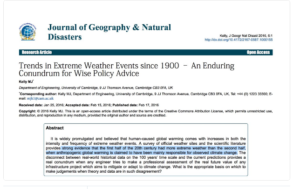Abstract:
It is widely promulgated and believed that human-caused global warming comes with increases in both the intensity and frequency of extreme weather events. A survey of official weather sites and the scientific literature provides strong evidence that the first half of the 20th century had more extreme weather than the second half, when anthropogenic global warming is claimed to have been mainly responsible for observed climate change. The disconnect between real-world historical data on the 100 years’ time scale and the current predictions provides a real conundrum when any engineer tries to make a professional assessment of the real future value of any infrastructure project which aims to mitigate or adapt to climate change. What is the appropriate basis on which to make judgements when theory and data are in such disagreement?
…
Core Conundrum Revisited
Items of physical infrastructure, for example, for housing, transportation, and energy supplies, must last 50-100 years, and are therefore generally designed to last over that period. Engineers involved in such projects have to assess the value-for-money for clients. Нey will be assisted by economic and environmental assessments, both of which will have uncertainties associated with predictions of the future. Extreme events play an important role in deciding the safety margins and the point where extra protection is not worth it. Нe lack
of clarity about future extreme weather, aіer 20 years of intensive analysis of future climates is deeply worrying. Нere is nothing that
emerges from references [1,2] that would require a significant refinement of the margins that have applied over the last half-century,
the engineering of the physical infrastructure. Over-adaptation that is not needed leaves clients free to sue advisors if the problems have been oversold and the costs of protection prove to have been excessive, even on a 20-year basis.


